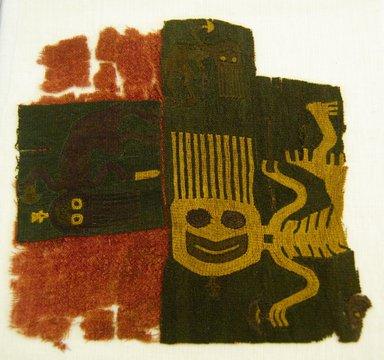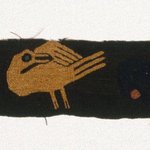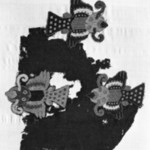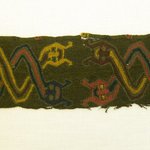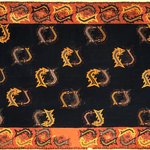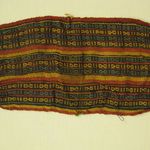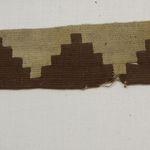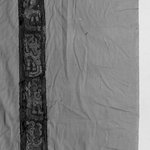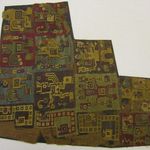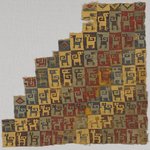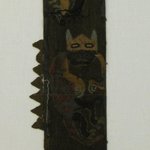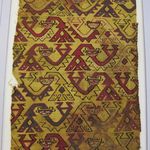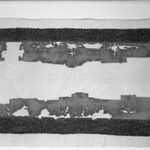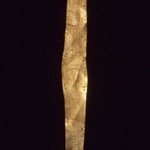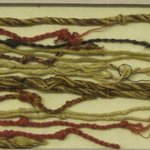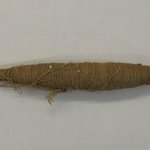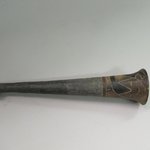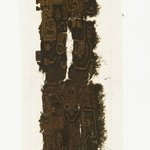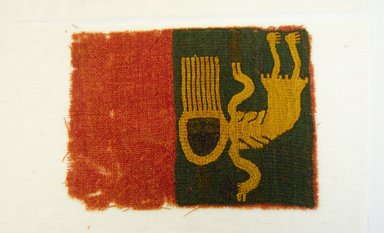
Textile Fragment with Skeletal Figure
Arts of the Americas
The backward-bent pose of this skeletal figure with long, streaming hair and a fan or knife in its hand is associated with sacrificial victims and death. At the throat, a square-shaped wound suggests a decapitation. Alternatively, the figure has been interpreted as the seminal being of a mythic transformation sequence in which supernatural beings evolve into more complex, composite figures such as the Plant Beings seen nearby.
CULTURE
Paracas
MEDIUM
Cotton, camelid fibers
DATES
100 B.C.E.–1 C.E.
DIMENSIONS
frag. a: 7 1/2 x 8 3/4 in. (19.1 x 22.2 cm)
frag. b: 6 3/16 x 4 1/2 in. (15.7 x 11.4 cm) (show scale)



COLLECTIONS
Arts of the Americas
ACCESSION NUMBER
33.570a-b
CREDIT LINE
A. Augustus Healy Fund
CATALOGUE DESCRIPTION
Two fragments from a Paracas mantle woven in red and brown with skeletal human figures holding fans or tumi knives. Larger fragment with face is "a"; smaller fragment with full figure is "b".
MUSEUM LOCATION
This item is not on view
CAPTION
Paracas. Textile Fragment with Skeletal Figure, 100 B.C.E.–1 C.E. Cotton, camelid fibers, frag. a: 7 1/2 x 8 3/4 in. (19.1 x 22.2 cm). Brooklyn Museum, A. Augustus Healy Fund, 33.570a-b (Photo: Brooklyn Museum, 33.570b_front_PS5.jpg)
IMAGE
component, 33.570b_front_PS5.jpg. Brooklyn Museum photograph, 2015
"CUR" at the beginning of an image file name means that the image was created by a curatorial staff member. These study images may be digital point-and-shoot photographs, when we don\'t yet have high-quality studio photography, or they may be scans of older negatives, slides, or photographic prints, providing historical documentation of the object.
RIGHTS STATEMENT
No known copyright restrictions
This work may be in the public domain in the United States. Works created by United States and non-United States nationals published prior to 1923 are in the public domain, subject to the terms of any applicable treaty or agreement.
You may download and use Brooklyn Museum images of this work. Please include caption information from this page and credit the Brooklyn Museum. If you need a high resolution file, please fill out our online application form (charges apply).
The Museum does not warrant that the use of this work will not infringe on the rights of third parties, such as artists or artists' heirs holding the rights to the work. It is your responsibility to determine and satisfy copyright or other use restrictions before copying, transmitting, or making other use of protected items beyond that allowed by "fair use," as such term is understood under the United States Copyright Act.
The Brooklyn Museum makes no representations or warranties with respect to the application or terms of any international agreement governing copyright protection in the United States for works created by foreign nationals.
For further information about copyright, we recommend resources at the United States Library of Congress, Cornell University, Copyright and Cultural Institutions: Guidelines for U.S. Libraries, Archives, and Museums, and Copyright Watch.
For more information about the Museum's rights project, including how rights types are assigned, please see our blog posts on copyright.
If you have any information regarding this work and rights to it, please contact copyright@brooklynmuseum.org.
RECORD COMPLETENESS
Not every record you will find here is complete. More information is available for some works than for others, and some entries have been updated more recently. Records are frequently reviewed and revised, and we welcome any additional information you might have.
